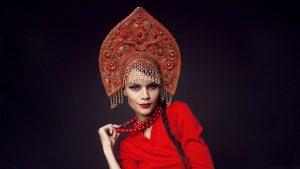 Have you ever attend an art performance and see the famous Russian traditional floating dance? You enjoy how these graceful dancers can glide as if their feet are above the ground. You wonder about how they do it. But most importantly, you wonder what these dancers are wearing above their head.
Have you ever attend an art performance and see the famous Russian traditional floating dance? You enjoy how these graceful dancers can glide as if their feet are above the ground. You wonder about how they do it. But most importantly, you wonder what these dancers are wearing above their head.
Congratulations, because you just discover Kokoshnik.
What is Kokoshnik? Kokoshnik is headdresses from Russia. It is traditionally worn by married women. Because once married, a woman should cover her hair and some times her neck too. Often, a kokoshnik is attached with a thin fabric like a veil. Unmarried women wear their own kind of Kokoshnik themselves. Throughout history, kokoshnik fashion always evolving. It used to be a popular headpiece for nobility and wealthy people.
Kokoshnik itself is taken from the semicircular arched shape that decorates many Russian buildings, especially in churches and cathedrals. There are so many forms of kokoshnik arts. We will learn about it later. Meanwhile, you can check some other Russian folk arts and Russian kaftan because they are as interesting.
Here are 5 kinds of Kokoshnik Arts:
1. Triangular Shaped Kokoshnik
Russia is a vast land, that is why kokoshnik in one part is different at another. In central Russia, the women wear a triangular shape one that’s different from people wear in Eastern Russia or Western Russia. Kokoshnik in this region looks like a half-moon or a crescent.
2. Kokoshnik in Northern Russia
Kokoshnik worn by women of the north is distinct because it is decorated with river pearls. They come with a small-cap attached to the headdress so the kokoshnik could cover all the head. This kokoshnik is worn during holiday only and during special events like weddings.
Kokoshnik in this region is decorated in elaborate decorations. It is embroidered with pearls in front, women would also add beads and a muslin shawl to complete the look. The maker of kokoshnik is called artists and they were sought after, just like today’s designer. And they are also sold in special events such as village fair or religious event.
3. Flower wreath and diadem
For the young unmarried woman, they are not required to cover their hair yet. So kokoshnik is not worn by young girls. Usually, young girls will part their hair in two and braid their hair down their head. Hair is a good sign of fertility. If a girl has good hairs, it is believed that she can produce healthy offspring. That’s why maidens in old-time Russia show their hair, unlike the married ones.
There are several traditions about wreath and diadem. For example, on a summer celebration young unmarried girls will float their wreath into the river and wait until it gets disappeared in afar. It is believed whose wreath reach the downstream first is the one getting married ahead of their peers. There is also another belief, if the diadem keeps floating, whatever the wish its owner has, it will come true. Otherwise, bad luck will befall upon those whose wreath sink to the bottom of the river.
4. Soroka
Kokoshnik is an elaborate fashion statement. It is adorned with jewelry and other precious stone. The fabric that used to make it is also special and some difficult embroidery works are included during the making of a kokoshnik headpiece. In the old russia, you can tell a woman status by looking at the headdress she wears.
So it’s clear. Kokoshnik is not definitely every day’s outfit for Russian women back then. Especially for peasants who have to work in the field, farming and other peasants work. Nobility might use it every day since they don’t have to work all day. But even then, it’s too much hassle to put on a kokoshnik every day.
So what do women wear instead? Especially the married women who had to cover their hair?
For this purpose, they have something called Soroka. Almost every peasant women know how to sew a soroka. It is what women wore every day instead of kokoshnik.
Soroka comprised of Kitchka, a small round cap usually made from canvas. Then there’s a linden from elm or birch tree. Kitchka has many shapes such as horn-shaped, spade shape or hoof shape, circle kitchka or oval kitchka. Soroka is also comprised of a shawl. The front and side are covered with embroidery and ribbon, called “nalobnik”. It is finished with a tie shawl.
5. Kokoshnik architecture
Kokoshnik isn’t just headdresses. It shares a name with an important element of Russian architecture. Kokoshnik is an arched shape you can find in churches and cathedrals. Kokoshnik design started to adorn holy places in the 16th century. They continued becoming popular and reached their peak of fame in the 17th century.
Kokoshnik design can be found on the roof part of the building, especially tented roofs. You can also find it on windows, walls, and the ceiling.
These are some buildings that apply kokoshnik arts:
a. The Church of St. Nicholas, located in Kolomna where five rows of kokoshnik adorn its roof
b. Donskoy Monastery
c. Spassky cathedral at the Andronikov Monastery
So, those are kokoshnik arts you learned today. Don’t stop until here. Learn also about ushanka, another Russian piece of clothing that shapes Russian fashion throughtout time. All these traditional clothes may sound interesting. But for practical tips, you can also learn about fashion rule in Russia today, so when you visit russia, you don’t dress wrong fashion.
